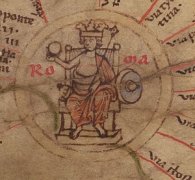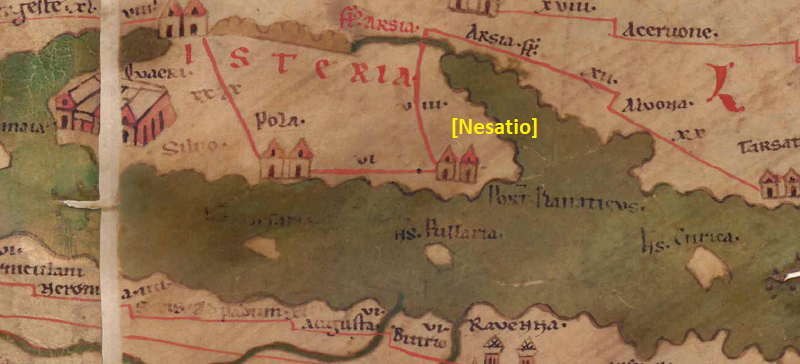
Tabula Peutingeriana – Pantalla individual
| Topónimo (simplificado): | [Nesatio]/Pola |
| Nombre (moderno): | Vizače (Barrington) |
| Imagen: |  Al detalle de la imagen |
| Topónimo antes | VI Pola |
| Topónimo después | VIII Arsia Fluvius |
| Imagen alternativa | --- |
| Imagen (Barrington 2000) | --- |
| Imagen (Scheyb 1753) | --- |
| Imagen (Welser 1598) | --- |
| Imagen (MSI 2025) | --- |
| Área: | Italia |
| Tipo de topónimo: | Símbolo sin nombre |
| Cuadrícula: | 4B1 |
| Color del topónimo: | sin color |
| Tipo de viñeta: | A Torre doble |
| Itinerario: |
|
| Nombres alternativos (diccionarios): |
|
| Nombre A (RE): | Nesactium |
| Nombre B (Barrington Atlas): | Nesactium (20 A5) |
| Nombre C (TIR / TIB /otros): |
|
| Nombre D (Miller): | [Nesatio] |
| Nombre E (Levi): | Portus Flanaticus (A,II,1) |
| Nombre F (Ravenate): | Nessatio (p. 68.13), Nesatium (p. 95.25) |
| Nombre G (Ptolemaios): | Νέσακτον τέλος Ἰταλίας (3,1,27) |
| Plinius: | oppidum Nesactium (3,129; 3,140) |
| Strabo: |
|
| Datación del topónimo en la TP: | --- |
| Fundamento para la datación: |
|
| Comentario al topónimo: |
Es handelt sich wohl in Wirklichkeit um Pola an der Südspitze Istriens, das durch den Fehler eines Zeichners/Kopisten auf der TP an die Stelle von Parentium verschoben erscheint (s. Degrassi 1939, 65f und Bosio 1974; vgl. dazu Art. Pola und Isteria). |
| Bibliografía: |
Bosio, Luciano: L´Istria nella descrizione della Tabula Peutingeriana, Trieste 1974, 63-67. |
| Última elaboración: | 30.10.2025 08:24 |
Cite this page:
https://www1.ku.de/ggf/ag/tabula_peutingeriana/trefferanzeige_es.php?id=671 [zuletzt aufgerufen am 14.11.2025]